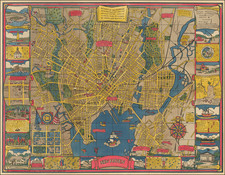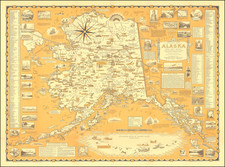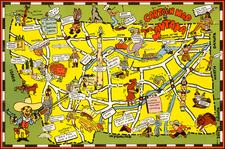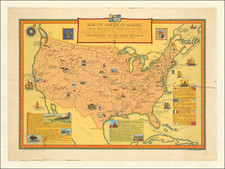Pictorial map of the Philmont Scout Ranch, hand drawn by Remington Schuyler.
Remington Schuyler was a commercial artist who was commissioned for a number of Boy Scout drawings dating to the 1920s-30s. Schuyler was known for his paintings and illustrations of the Old West, Native Americans, and Boy Scouts.
Philmont Scout Ranch
The Philmont Scout Ranch is a ranch located near the town of Cimarron, New Mexico covering approximately 219 square miles of wilderness in the Sangre de Cristo Mountains of the Rocky Mountains. Donated by oil baron Waite Phillips in 1938, the ranch is owned and operated by the Boy Scouts of America. It is a National High Adventure Base where crews of Scouts and Venturers take part in backpacking treks and other outdoor activities. By land area, it is one of the largest youth camps in the world. During the season, between June 8 and August 22, an estimated 22,000 Scouts and adult leaders backpack through the Ranch's extensive backcountry. More than 1,130 seasonal staff are responsible for the Ranch's summer operations.
The Santa Fe Trail crossed the plains just southwest of Philmont in the mid-1800s. The Tooth of Time owes its name to this trail; travelers knew that once they passed it, they had only one week to go until they reached Santa Fe, New Mexico. Philmont's strategic location along the trail spurred some interest in it. In 1841, Carlos Beaubien and Guadalupe Miranda obtained a large land grant from the Mexican government, including the present ranch. Soon the grant fell into the hands of Beaubien's son-in-law Lucien Maxwell, who played an important role in developing and settling it. Maxwell sold the ranch to the Maxwell Land Grant and Railroad Company, which gave up and handed it on to a Dutch development company, which decided to parcel it out to ranchers.
One of the most prominent ranchers was Jesus Gil Abreu, who ran the Abreu Rayado Ranch from the 1870s to his death in 1901. Operating from the Rayado Settlement, he raised cattle, goats, and sheep and grew crops. The family owned this property until 1911, when they sold most of it off. One of the sons remained on the ranch near the site of Abreu, a present staffed camp, and his homestead was preserved for years. The building was made of adobe, was abandoned and eventually collapsed. The foundation of this building now serves as the foundation for the Abreu cantina. The house was reconstructed in 1998 about 100 feet (30 m) uphill.
The history of mining at Philmont dates back to the years immediately after the Civil War. U.S. soldiers were stationed in the West after the war, as the U.S. Army was driving out the American Indians. The story is that one of these soldiers befriended an Indian, who happened to give him a shiny rock. The shiny material in the rock was found to be copper. According to the story, the soldier and two of his friends went up to investigate, and found gold. They could not stay to mine the gold and the area was overrun by miners by the time they returned the next year. Scores of gold mines were excavated in Philmont, and operated into the early 20th century. A large vein of gold is said to lie under Mount Baldy to this day, but extracting it has not been feasible. It is a common joke at Philmont that some day the mines under Baldy will collapse and Phillips will be the highest mountain in Philmont. The Contention Mine, located at Cyphers Mine, and the Aztec Mine, located at French Henry, are open to guided tours.
Wealthy oil magnate and wilderness enthusiast Waite Phillips amassed a large part of the old land grant in the 1920s, totaling over 300,000 acres. Phillips built a large residence in the lowlands of Philmont. He turned the ranch into a private game reserve for himself and friends, and built a number of hunting lodges and day-use camps. He chose not to provide electricity at the remote camps. A few of these original camps, including Fish Camp and the Hunting Lodge, have been preserved, complete with wood-burning stoves, oil lamps, and unique design features indicative of Phillips's often eccentric taste.
Phillips sometimes allowed others, including a few Boy Scout troops, to visit his ranch. He was so impressed with the Scouts that in 1938, during the Great Depression, he donated 35,857 acres of his land to the Boy Scouts of America. His only condition was that the property be used "for the benefit of the members of the Boy Scout organization". He donated a second, larger section of land later in the 1930s, requiring only that this section pay its fair share of taxes on any portion devoted to competitive commercial operations.












![[ The Silver Route -- Mexico City to Santa Fe, New Mexico ] Carte de la Route qui mene depuis la Capitale de la Nouvelle Espagne jusqu'a S. Fe. du Nouveau Mexique Dressee sur les Journaux de Don Pedro de Rivera et en partie sur les Observations Astronomique de Mr. de Humboldt.](https://storage.googleapis.com/raremaps/img/small/102164.jpg)

